- This
part covers period 1526 to 1707 and includes Mughal rule esp. intolerance
towards Hindus, Hindu warrior Hemu and Tansen.
Shri
V Balachandran (ex-Special Secretary Cabinet Secretariat) wrote in The Tribune
Chandigarh Neglecting cultural czar Munshi’s efforts This goaded me to do a precis of Foreword of 11 Volumes of The History and Culture of Indian People. We present precis of Volume 7.
Respected
K
M Munshi was an educationist, freedom fighter, founder of Bharatiya
Vidya Bhavan (1938), author and worked closely with Sardar Patel. He initiated
the writing of The History and Culture of
the Indian People. The books are a masterpiece & my constant reference
book. Shri R.C. Majumdar was General Editor. Of volume 7, J.N. Chaudhuri and S.
Chaudhuri were Assistant Editors.
K M Munshiji said, “That although efforts to prepare this massive history-writing had started in 1938, it could assume concrete shape only in 1944 with generous help from GD Birla and the Shri Krishnarpan Charity Trust.”
Precis
is split in parts. Each part has a number and title that represents content.
Let us hope these books become part of the mainstream educational system.
Part
1
covered period 1000-1300 and includes state of Indian society around 1000, why
did it survive the earlier 2,000 years, status of Sanskrit, social impact of
Muslim invasions, why lower strata of society adopted Islam, South Indian kings,
rise of Desabhashas and Bhakti.
Part
2
covers period 1300 to 1526. It tells did Khilji/Tughluq rule all of India, Timur
invasion, what is common between Timur and Vasco da gama, Religious Life then, Impact
of Islam, Religious life and Language Literature and did Muslim or Hindu ruler
of Orissa support Chaitanya Mahaprabhu.
This
part covers 1526-1707. It includes Mughal rule esp. intolerance towards Hindus,
warrior Hemu and Tansen.
My
only contribution is doing a precis of the preface. This piece is courtesy the
publisher, Bharatiya Vidya Bhavan Mumbai.
The Mughul Empire (period 1526-1707) Preface by Dr R.C. Majumdar
This
volume was published in 1974 after Shri K M Munshi passed away. So we are
presenting excerpts from Preface written by General Editor, Dr R.C. Majumdar.
For sake of consistency the title remains the same except the period.
I Mughul Rule / Intolerance towards Hindus
“This is the period during which the Mughuls gradually established their authority over nearly the whole of India. The Mughal rule is distinguished by the establishment of a stable Government with an efficient system of administration etc. and wealth and splendour such as no other Islamic State in any part of the world can boast off.
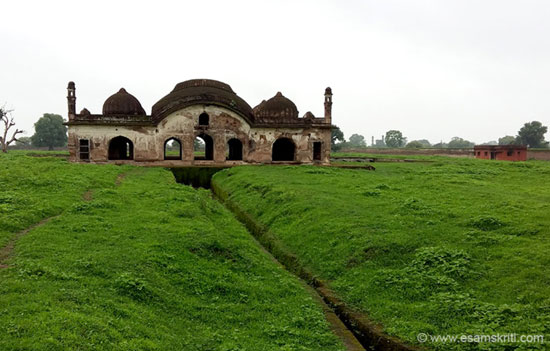 Near Burhanpur, MP. This is where Shah Jahan’s wife Mumtaz Mahal was first buried. She died in 1631.
Near Burhanpur, MP. This is where Shah Jahan’s wife Mumtaz Mahal was first buried. She died in 1631.
During
this period there was no improvement in their moral or material condition or in
their relations with Muslims. With the sole exception of Akbar, almost all
other Mughal Emperors were notorious for their religious bigotry. Muslim law
which imposed many disabilities and indignities upon Hindus was followed by
them with as much zeal as was displayed by their predecessors, the Sultans of
Delhi.
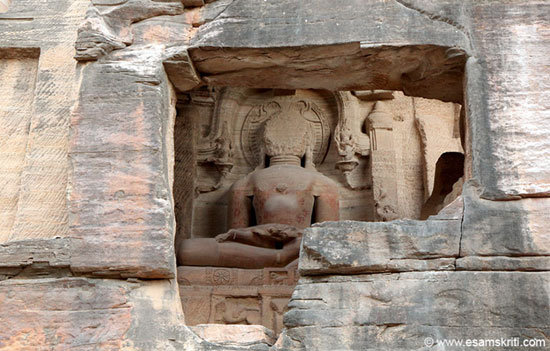 Faces of Jain Tirthankara, Gwalior Fort destroyed by Babur or Aurangzeb.
Faces of Jain Tirthankara, Gwalior Fort destroyed by Babur or Aurangzeb.
The
climax was reached during the reign of Aurangzeb, who deliberately pursed the
policy of destroying and desecrating Hindus temples and idols with a
thoroughness unknown before or since.
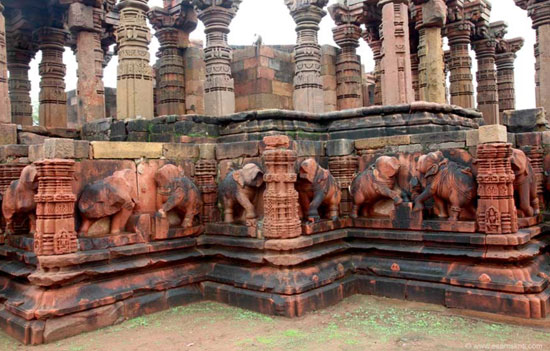 Elephant trunks broken by invaders, Siddhanath Mandir Omkareshwar, most probably Aurangzeb.
Elephant trunks broken by invaders, Siddhanath Mandir Omkareshwar, most probably Aurangzeb.
In
the present volume, reference has been made to Muslim bigotry in general and
the persecution of Hindus by Aurangzeb in particular (pp.233-36, 305-6). There
is a distinct and conscious attempt to rewrite the whole chapter of the bigotry
and intolerance of the Muslim rulers towards Hindu religion.
This
was originally prompted by the political motive of bringing together Hindus and
Muslims in a common fight against the British but has continued ever since.
If
we consider the relevant facts of history as discussed, in an open mind, we can
never deny that religious bigotry contributed to a very large extent to the
downfall of the mighty Mughul Empire. It is true that there were other causes
at work such as fratricidal wars of succession.
We should remember that there were similar wars also just before Aurangzeb ascended the throne, the Mughul Empire survived because it could count on the loyal support of the Rajputs and had not to encounter opposition of the Rajputs or of the Marathas and the Sikhs whom Aurangzeb’s bigotry had converted into deadly enemies.
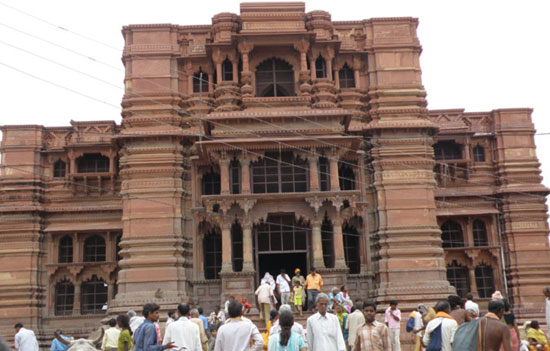 Govind Temple Vrindavan, originally 7 storey, destroyed by Aurangzeb. Built by Raja Mansingh in 1590.
Govind Temple Vrindavan, originally 7 storey, destroyed by Aurangzeb. Built by Raja Mansingh in 1590.
Nevertheless
Aurangzeb must be regarded as a very able ruler. It was he who extended the southern
boundary of the Mughal Empire, which then included the vast region from the
Hindu Kush and the Himalayas, to Cape Comorin. For a near parallel we have to
look back at the Maurya Empire that flourished about 2,000 years ago.
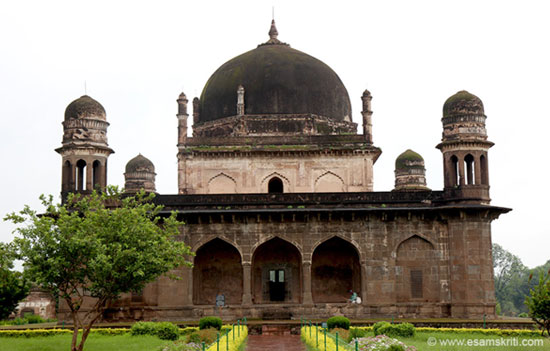 Tomb of Shah Nawaz Khan near Burhanpur M.P. It is called Black Taj Mahal for its resemblance to the Taj.
Tomb of Shah Nawaz Khan near Burhanpur M.P. It is called Black Taj Mahal for its resemblance to the Taj.
The
Mughul period should also be credited with great artistic achievement for e.g.
the Taj Mahal. Mughal paintings have also received a world-wide renown.
Finally, India during the Mughul period enjoyed a reputation for wealth and
splendour which attracted a large number of visitors from Europe.
II Kings next to Mughals
Next
to the Mughals, the Rajput States in the north, the five Sultanates of the
Deccan arising out of the ruins of the Bahmani kingdom, and the Hindu Empire of
Vijayanagara played a dominant role in history at the beginning of this period.
(1527). The end of this period witnessed the rise of two great powers, the
Marathas and Sikhs who were destined to play the most prominent role in the 18th
century.
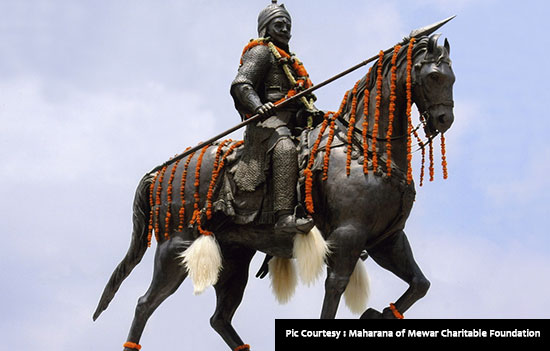 Maharana Pratap.
Maharana Pratap.
During
this period were a number of great personalities who left a deep impress upon
the political history of India. These were Babur, Sher Shah, Hemchandra, Akbar,
Chand Sultan, Rana Pratap Singh, Nur Jahan, Shivaji, Bajirao and Guru Govind
Singh.
III Hemu
This
volume may claim credit for rescuing from oblivion the name of Himu or
Hemchandra, a forgotten Hindu hero who began his life as a greengrocer, and by
dint of his own efforts and personality ascended the throne of Delhi- the only
Hindu to do so after the Battle of Tarain in 1192 A.D.
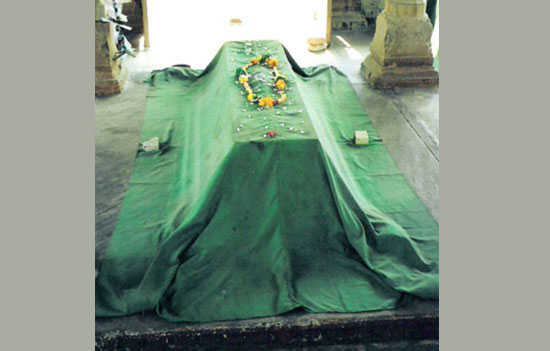 Tansen Tomb Gwalior. He was the child of Laxmi Bai and Makrand Pandey.
Tansen Tomb Gwalior. He was the child of Laxmi Bai and Makrand Pandey.
IV Tansen and Tulsidasa
To
the above names, add Tulasi-dasa and Tansen whose influence still persists over
Hindi literature and classical music of India.
This
volume gives a brief account of the 14 local vernacular literatures, most of
which were yet at their formative stage.
There is a view that the development of Bengali literature was rendered possible by the enlightened rule of Hussain Shah, the Sultan of Bengal whose rule ended in A.D. 1519. The Editor feels, that Hussain Shah had no reasonable claim to be regarded as the promoter of the development of Bengali literature.” End of quote.
The above excerpts
are courtesy and copyright the publisher the Bharatiya Vidya Bhavan, Kulapati K.M.
Munshi Marg, Mumbai-400007, India.
eSamskriti has obtained permission to share from the Editorial Advisory
Board of Bharatiya Vidya Bhavan.
To
read full Foreword visit the Bhavan site and HERE (shall be uploaded shortly)
To buy
book The History and Culture of Indian People at Bhavan’s Online Store or on
Amazon
To
subscribe to the Bhavan’s Journal To
read on Culture
To
read Vande Mataram (English translation by Sri Aurobindo)
Also read
1. Atrocities
of Mughal Emperors in India
2. Re-examining history – The Making the Taj
3. Lachit
Borphukan Memorial Assam-he defeated Aurangzeb’s forces in a naval battle fought on the Brahmaputra. Final battle fought in 1671.
4. Life
of Sant Tulsidas
5. Hindustani Classical Music – evolution and emotional synthesis